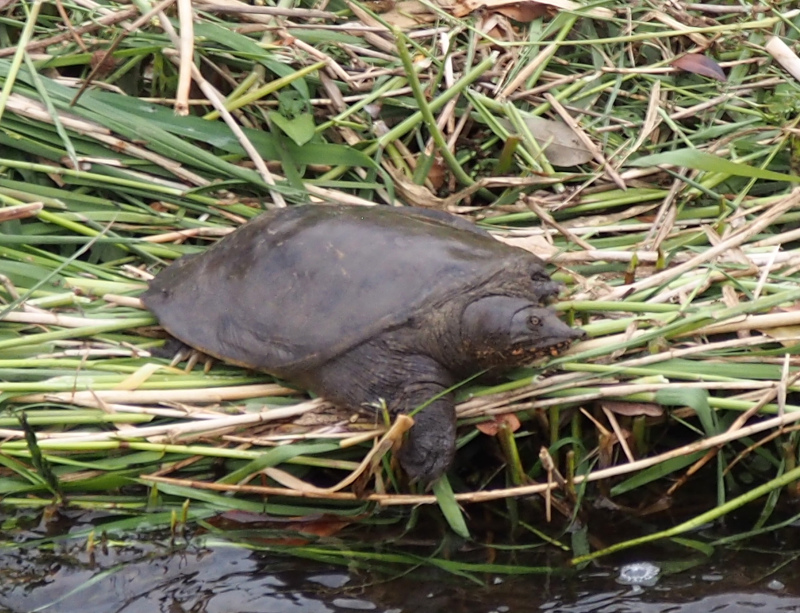| Pelodiscus turtles in Daiba river |
Summary: A population of softshell turtles appeared in the lower Daiba river.
Background
|
Daiba river is a river in Shizuoka prefecture, Japan. It runs westward from the western side of Hakone, then southward through Susono and Mishima cities, before merging into Kano river. The map on the right shows the lower Daiba river (highlighted in red) in Mishima (click to enlarge). Arrow indicates direction of its flow. |
Pelodiscus is a genus of softshell turtles, native to East Asia. Two species possibly relevant here are Pelodiscus sinensis and Pelodiscus maackii. It's called "Suppon" in Japanese. They are raised in turtle farms and also sometimes kept as pets. These turtles are known to form invasive populations when given the chance.
"Turtles of the World", 8-th edition (Turtle Taxonomy Working Group 2017) shows the following maps of distribution of P. sinensis (left) and P. maackii (right):
 |
 |
Both maps have orange dots in Japan, indicating "possibly native or historic introduction". The nearest dots to Mishima are around Omaezaki (for both species) and in Chiba for P. sinensis. No dot is shown for Mishima.
|
Fritz et al (2010) analyzed Pelodiscus sampled at the locations shown on the map on the right. They sequenced and compared short DNA fragments (2,419 bp of mtDNA and a 565-bp-long fragment of the nuclear C-mos gene). Relevant parts: "Traditionally, all populations were assigned to the species P. sinensis (Wiegmann, 1834); in recent years up to three additional species have been recognized by a few authors, while others have continued to accept only P. sinensis." "Our findings provide evidence for the existence of at least seven distinct genetic lineages and suggest interbreeding in commercial turtle farms." "The validity of P. maackii (Brandt, 1857) from the northernmost part of the genus’ range is confirmed, whereas it is unclear which names should be applied to several taxa occurring in the central and southern parts of the range." No samples from Japan were included, and their map only shows question marks in Japan. |
|
Suzuki and Hikida (2014) did a crucial study of Pelodiscus distribution in Japan. Their map (shown on the right) shows P. maackii (white) and P. sinensis (black) mtDNA haplotype frequencies at sampled locations. From abstract: "The results strongly suggested the presence in Japan of various mitochondrial haplotypes that largely formed two divergent groups, one supposedly corresponding to P. sinensis (Wiegmann, 1834) sensu stricto and the other to P. maackii (Brandt, 1857). Haplotypes putatively associated with P maackii were unique to, and broadly prevailing in Japan. This may reflect indigenous nature of P. maackii in Japan, which would be more appropriately referred to as P. japonicus (Temminck and Schlegel, 1835). The others, putatively associated with P. sinensis, were fewer in Japan, and included those shared with individuals sold in a fish market of the continental China, suggesting the current Japanese P. sinensis to be exotic." |
Other interesting DNA-based investigations of Pelodiscus diversity were done by Zhang et al. (2014) and Gong et al. (2018).
More recently Farkas et al. (2019) provided the following map of Pelodiscus distribution (mainly based on "Turtles of the World" data):
The "Invasive Species of Japan" website has a page for P. sinensis (link). The page has the following map, indicating that this species is native in entire Honshu.

iNaturalist has observations for P. sinensis (left) and P. maackii (right). However, none in Shizuoka prefecture so far (as of April 8, 2021):
 |
 |
Softshell turtles are farmed commercially in lake Hamana near Hamamatsu (link). Turtle farming exists in Japan since 1866 (Mitsukuri, 1905).
Observations
On April 2, 2021, while walking along the Daiba river with my daughter, we found 4 turtles basking on river's edge. When we tried to get closer to them, they escaped into water.
It was a warm sunny day, time was around noon. Turtles looked agile and healthy. They were adult-sized.
I lived in Mishima before 2013, and I often used to walk along the Daiba river. I am very familiar with this same stretch of Daiba river, and there were no turtles there at that time. 4 adult turtles means they arrived a few years ago, but sometime within the last 10 years. Therefore, formation and expansion of this population is most likely still an ongoing process.
Since then I saw these turtles a few more times. Also, Kaisar Dauyey joined observation and sent me his photo.
Photos
Daiba river, upstream from Ayudome Falls













